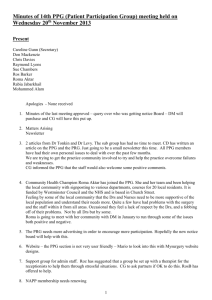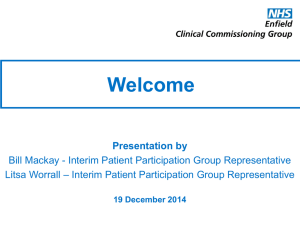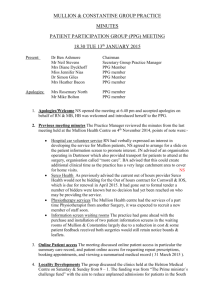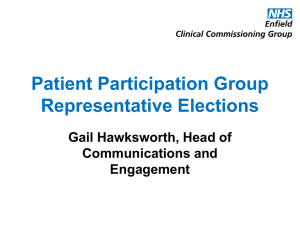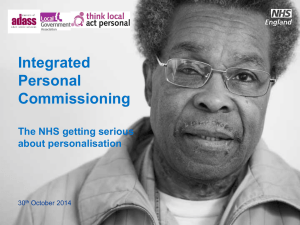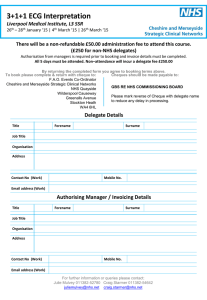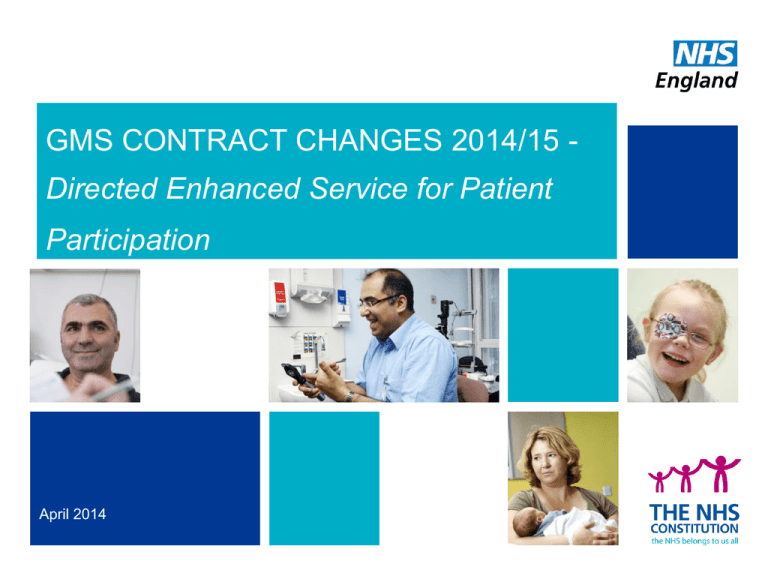
GMS CONTRACT CHANGES 2014/15 Directed Enhanced Service for Patient
Participation
April 2014
Directed Enhanced Services 2014/15
Patient Participation Directed Enhanced Services to be
re commissioned in 2014-15
• Funding will be 0.36p per registered patient if they achieve all components
• No longer any payment weighting for developing a PPG Group as this is now a
prerequisite
• No requirement to carry out a local patient survey, though collecting feedback is
still required to inform the development of the action plan
• The scope of the Enhanced service has been revised and the funding set at a
maximum of £20m with the remaining £40m of funding to be invested in the
global sum to fund workload and costs associated with the introduction of
Friends & Family test
2
Purpose of the Enhanced Service
P
• To ensure that patients and carers are involved in decisions about the range, shape and quality of servcies
provided by their GP Practice
• Aims to promote the proactive and innovative engagement of patients and carers through the effective use
of PPG’s and to act on a range of sources of patient and carer feedback
Sources of Patient and Carer Feedback
• The GP Patient Survey ( 6 monthly)
• Reviewing complaints and suggestions from practice post box, online forums and any other existing
practice surveys
• Local voluntary or community groups or existing groups attached to the practice Healthwatch
• Practice Champions and peer support groups
• Other local surveys arranged by the CCG or Commissioning Support Units
• CQC reports
• The Friends & Family Test ( when available)
• 3NHS Choices
Key requirements of the DES
Develop/maintain a PPG that gains the views of patients and carers and
enables the practice to obtain feedback from the practice population. This is
a prerequisite of the ES
PPG and staff to review patient feedback received by the practice from sources such as
those previously listed. Frequency of the review to be agreed with the PPG
Practice and PPG should develop and agree an action plan ( based on three priority
areas) and agree how the practice will implement improvements
Practice should publicise actions taken to practice population including providing the PPG
with updates on progress and assessment of subsequent achievement within the
timescales agreed
The practice and the PPG will have to complete a reporting template to report actions
taken during the year, involvement of the registered patients and used to its best
endeavours to ensure that the PPG is representative of its registered population.
/
4
PPG Development & Patient Engagement
• PPG should be representative of the practice population as far as possible. Practices should do a
profile of their population ( not just age and sex) but take account of factors such as unemployment,
number of carers, black and ethnic minority groups, marginalised or vulnerable groups ( e.g. older frail
people or patients with learning difficulties)
• Local voluntary groups may be able to support practice in engaging with certain groups of people e.g
Learning disabilities, carers, mothers and toddlers etc
• All practice will have a significant number of patients who are children. It will be up to the practice to
determine how best to seek their views. While there is no requirement for under 16s to be part of the
PPG, practices may involve them, subject to parental consent and may wish to consider how they can
be involved.
• PPG’s should be of a reasonable size which is representative of the practice population.
• Where a practice is unable to encourage patient participation by certain groups, it must demonstrate
what steps it has taken to try and engage that group. The practice and the PPG may find it useful to
reach out by doing a focused piece of work to engage them or by linking in with a local community or
voluntary group.
• Practices should aim to have continual dialogue around improvement with their PPG and wider
registered population and should reflect on existing and new sources of feedback.
• The practice should agree with the PPG how regularly that feedback is reviewed.
5
Identifying Areas of Priority
Using a variety of sources of feedback the practice and the PPG should identify areas of priority.
These are likely to be based on key inputs, including the identification of:
• Patients and carers priorities and issues
• Practice priorities and issues including themes from complaints
• Planned practice changes
• CQC related issues
• National GP patient survey
Practices and PPGs should agree an action plan for the priority areas, how the practice will report back on
how these priorities have been met and how they have achieved improvements for the quality of outcomes
for patients.
Where a practice proposes any significant change to a service or services it provides to which the PPG
agreement has not been obtained, the practice must obtain agreement of NHS England to its proposals.
6
Monitoring
• Practices should publicise actions taken and provide the PPG with updates, report actions taken during the
year, involvement of the PPG and the outputs which have been achieved
• Practices will be expected to make their practice population aware of the actions taken for the three
priorities. They can choose to do this through one or more of the following options; through the practice
website, the NHS Choices website, posters in the waiting room and/or summary results sent to those who
took part in any surveys.
• Where there is ongoing disagreement with the PPG on proposed actions, this must be publicly highlighted
with the practice’s rationale for deviating from the accepted plan
• There should be evidence that the PPG is content with the views expressed in the reporting template
7
Patient Participation Payment Split
Revised to remove requirement to carry out local patient survey, though collecting feedback is
still required
•
£0.36 per registered patient based on achievement of the three components;
Develop a PPG
Prerequisite of ES
PPG and practice to review patient feedback received by the practice (from a
variety of sources such as those listed) at a frequency agreed with the PPG and
reach agreement on priority areas
30%
Practice and PPG to develop action plan for implementing changes based on at
least three key priority areas.
30%
Practice to implement improvements and publicise actions taken to practice
population including providing the PPG with updates on progress and
assessment of subsequent achievement within the timescales agreed. Practice
and PPG to complete the reporting template to report actions taken during the
year, involvement of the PPG and the outputs which have been achieved.
Practices to post reporting templates on website by 31 March 2015.
40%
• Patient feedback can be taken from various sources i.e. complaints, national GP survey, PRG
priorities, planned changed, CQC related issues
• Friends and family test to be implemented December 2014
8
Report circulation
• The report must be submitted by the practice no later than 31 March using the reporting template to
NHS England for payment to be made. Payment for achievement of a component is dependent on
the previous components having been completed.
• Practices should ensure that the following are made aware that the report is available and where it
can be viewed:
• The PPG
• This who answered any bespoke surveys issued by the practice
• The wider practice population
• The CCG
• Local Healthwatch
• Local voluntary and community groups
• CQC – at the time of inspection/registration
9
• ,
Principles of Participation
10
CWW Area Team support
• Directed Enhanced Service queries should be sent to your Account Manager
• Michael.anderson4@nhs.net
Wirral
• Stellawhite@nhs.net
Vale Royal
• Lynndavison@nhs.net
Eastern Cheshire
• Jane.Conder@nhs.net
Warrington
• Brigitte.Stevenson@nhs.net
South Cheshire/West Cheshire
• Presented by: Cathy Rowlands, Medical Contract Support Manager
11


